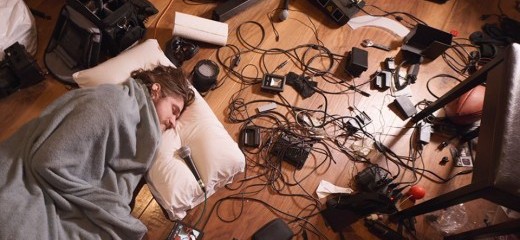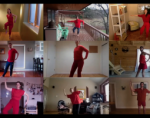
Body to body: Bo Burnham’s Inside
by Kat J. Sullivan
I watch Bo Burnham fling his arms to the side as if being pinned, as if against a cross, as if simultaneously cracking open his torso and holding back the waves of a flood just about to break. His pale body is illuminated by a strip of light, throwing the bones of his ribs and clavicle into contrast. Hair damp with sweat, he casts himself against the wall behind him as he croons the chorus of “Problematic,” one of several songs in his newest comedy special on Netflix, Inside. Burnham’s muscles are taut. Through the filtered light of window blinds, the long fingers of his hand are outstretched, and his wrist tented and writhing as he theatrically convulses from side to side on the beat.
I watch my square on a Zoom call, though I can’t see my own face because my thumb conceals my camera. I am signaling myself done. At the end of a week-long online dance intensive, I am part of an ensemble reaching the final moments of our closing dance, and I watch as others slowly eclipse their images with the crescent of their thumb pads. When the host ends the Zoom, I sit there for many more moments like that, with my thumb pressing against the top of my screen, sitting on the floor in front of my desk with my legs curled into my right side. When my laptop falls into sleep mode, the black emptiness of the screen mirrors my face back at me. I close the computer shut and fold myself in half in just the same way, lowering into a sob.
I watch Bo Burnham sitting far from the camera, taking in his simple white room and surrounding netting of cables, wires, plugs, computers, lights, instruments, the lone and strangely sweet wooden dresser. He is perched askance on a stool, eyes closed, holding a microphone. As he attempts to record himself admitting his stricken mental state, he stutters and falters. His unkempt hair falls further in his face as he collapses in on himself. An arm pushing against a knee like a kickstand, his hands shaking and going pale at the knuckle from gripping. In frustration, Burnham maliciously storms off camera, stomping through his equipment, his lanky form graceless and heavy.
I watch myself in the tiny square in the corner of my FaceTime call with my therapist. She is talking about something important. Despite the solemnity I see etched into my jaw, my eye sockets, I’m using all my might to combat the barrage of intrusive thoughts bombarding me, a symptom of my obsessive-compulsive disorder. I’m afraid to move; everything feels like a danger, including and especially my rigid body. I sit with my left leg bent across the chair, foot pressing into my right thigh, and my breathing darts into my upper chest. “Does that sound like the right next step?” my therapist says. “What?” I say.
I watch Bo Burnham’s Inside at the start of June, just as many masking, distancing, and capacity restrictions are lifting in Philadelphia. Over the course of the special, Burnham shows himself unravelling, alone. Boxing Inside as a comedy is either too reductive or optimistic, as moments of comedic genius are thrown into contrast by equally genius moments of deep, deep pain. I’m watching and I’m laughing; I’m crying; I’m laughing because I’m crying; I’m crying because I’m laughing.
Burnham is a gifted performer (and writer, and director, and editor; Inside was created by him and him alone as a result of the pandemic) and, while not one for pratfalls or cartwheels, he is a very physical comedian. “White Woman’s Instagram” comes to mind, in which Burnham recreates images associated with a stereotypical white woman’s social media page with himself, posing with garlands of faux autumnal leaves, demurely looking into the distance with a glass of wine, or lounging in an oversized sweater. The choreography is stylized down to the minute glance or step, signified by its connection to lighting, camera angle, or musical changes. So when I see Burnham lying undone on the ground under a blanket amid a chaotic nest of production equipment, attempting to record voiceover with a weak voice for the section I just watched, it feels intentional too. I am supposed to be watching this.
When I watch Bo Burnham wiggle his hips in a self-mockingly effeminate manner in “Comedy,” I see myself alone in my room in a trash bag, unsuccessfully trying to film an homage to Martha Graham’s Lamentations for a school assignment this past March. When I watch the camera slowly zoom in on his hands as he sobs despondently into them towards the end of the work, I see myself standing in the grass of my backyard last May after not leaving my house for 52 straight days. From one body to another, I watch Inside and recognize the absurdity, the horror, the pageantry, and the grief in Burnham’s flicking eyes, in the jolt of his shoulder, as well as in my own.
Inside, Bo Burnham, Netflix, premiered May 30.
By Kat J. Sullivan
August 3, 2021










